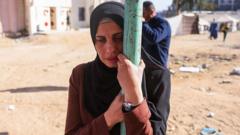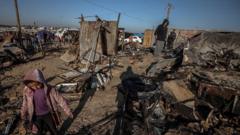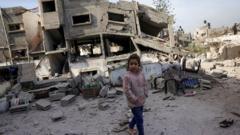Civilians in Gaza face stark choices as Israeli evacuation orders complicate their lives in war-torn regions.
Evacuation Orders Force Gazans into Heart-Wrenching Decisions

Evacuation Orders Force Gazans into Heart-Wrenching Decisions
Israeli military orders raise dilemmas for residents amid ongoing conflict in Gaza
The Israeli military is intensifying its offensive in the Gaza Strip, prompting new evacuation orders primarily targeting eastern Gaza City. This escalation comes after a collapse of the cease-fire between Israel and Hamas in March, leading to painful decisions for Palestinians on whether to remain in their homes or risk displacement.
As the Israeli military continues its operations, areas previously marked as evacuation zones are once again in focus, suggesting that some residents have defied earlier warnings to evacuate. Consequently, the United Nations reports a staggering 390,000 people have been made homeless in the past few weeks, yet the precise numbers of those still in designated evacuation zones remain uncertain.
Ahmad al-Masri, a 26-year-old resident of Beit Lahia in northern Gaza, voiced the anguish of many, stating, “We don’t want to leave. Where will we go? It’s so very tiring.” This sentiment echoes throughout the region, where people grapple with the terrifying uncertainty of remaining in potentially dangerous areas versus leaving and enduring difficult conditions in displacement.
Military operations have varied—some neighborhoods face both evacuation orders and subsequent ground invasions, while others only receive evacuation warnings without immediate action. Residents have expressed that they would reconsider their stance on evacuating if they see signs of military advance into their neighborhoods.
As tensions escalate and choices become increasingly dire, the plight of the civilians in Gaza underscores the human cost of the ongoing conflict amid a backdrop of complex political dynamics.
As the Israeli military continues its operations, areas previously marked as evacuation zones are once again in focus, suggesting that some residents have defied earlier warnings to evacuate. Consequently, the United Nations reports a staggering 390,000 people have been made homeless in the past few weeks, yet the precise numbers of those still in designated evacuation zones remain uncertain.
Ahmad al-Masri, a 26-year-old resident of Beit Lahia in northern Gaza, voiced the anguish of many, stating, “We don’t want to leave. Where will we go? It’s so very tiring.” This sentiment echoes throughout the region, where people grapple with the terrifying uncertainty of remaining in potentially dangerous areas versus leaving and enduring difficult conditions in displacement.
Military operations have varied—some neighborhoods face both evacuation orders and subsequent ground invasions, while others only receive evacuation warnings without immediate action. Residents have expressed that they would reconsider their stance on evacuating if they see signs of military advance into their neighborhoods.
As tensions escalate and choices become increasingly dire, the plight of the civilians in Gaza underscores the human cost of the ongoing conflict amid a backdrop of complex political dynamics.




















